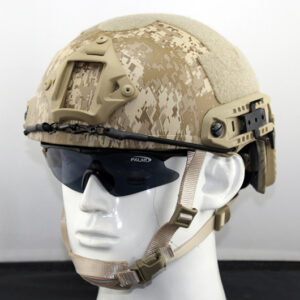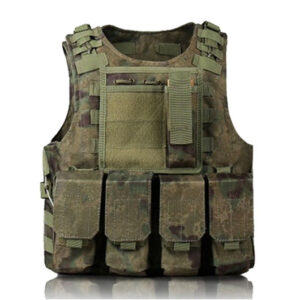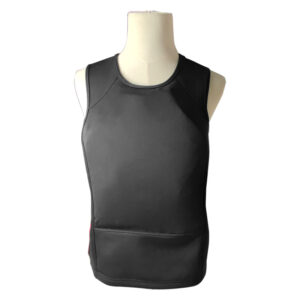MATERIALS
The ballistic panels used in bulletproof vests can be made up of different materials, depending on the manufacturer. Body armor must pass specific tests before it can be sold, so the different materials should all provide the same minimum levels of protection. Unfortunately, this is not always the situation, as some types of body armor, such as Zylon, have been shown to fail after short periods of use. After its release, Zylon was shown to degrade rapidly by independent tests, and this led to the recall of all Zylon-based bulletproof vests in 2005. When purchasing body armor you should always ensure that it is made from trusted, high-quality materials such as those listed below.
PARA-ARAMIDS
Aramids are man-made synthetic fibers that are heat resistant and incredibly strong, with outstanding strength-to-weight ratios. They were developed in the early 1960s and mainly pioneered by DuPont™, who developed a meta-aramid called Nomax®. Further developments by DuPont led to the introduction in 1973 of their first para-aramid, Kevlar®. This led to a revolution in the bulletproof vest industry, as Para-aramid materials allowed body armor manufacturers to develop bulletproof vests that were lightweight and flexible, and which also offered a high level of protection to the wearer. Materials used for bulletproof vests such as Kevlar and Twaron® are para-aramids and have been used in body armor for nearly 30 years.
Aramids are generally formed by a reaction between an amine group and a carboxylic group, which creates an AABB polymer. This liquid chemical blend is then made into its solid form by spinning it together with sulfuric acid, which when cooled can be made into a fiber, powder, or pulp.
Kevlar has gone through several stages of development since first being introduced in the 1970s. The first version, Kevlar 29, was a revolutionary step for body armor, as it allowed for the production of protective panels that were both flexible and also easily concealable. This meant DuPont could now produce a piece of body armor that was lightweight, and that could be worn comfortably by people on a day-to-day basis. DuPont continued to develop Kevlar for use in body armor, and in 1988 they released their second version, known as Kevlar 129. This improved version was even lighter than Kevlar 29 and offered increased ballistic protection for the wearer, including protection against high energy rounds from weapons like a 9mm FMJ.
The most recent version of Kevlar was released in 1995 and named Kevlar Correctional. This revolutionary version could stop attacks from knives and other such weapons, and led to the production of lightweight, multi-threat forms of body armor that were capable of stopping both ballistic and stab threats.
ULTRA-HIGH-MOLECULAR-WEIGHT POLYETHYLENE
Ultra-high-molecular-weight polyethylene, or UHMWPE for short, is another popular choice for ballistic panels and is used in many modern types of body armor It has many similar characteristics to para-aramids, but is a type of polyolefin, made up of extremely long chains of polyethylene.
UHMWPE can be formed in several different ways, including ram extrusion and compression molding. However, when it is used for body armor it is created using a process called gel-spinning. This involves drawing dissolved ethylene through a series of small holes, which creates a gel material. Two pieces of this gel are then sealed within polyethylene film, and this creates a composite that can then be made into both flexible, lightweight ballistic panels, or more rigid, hard armor plates.
Research has shown that the strength-to-weight ratio for UHMWPE can be up to 40% higher than that of traditional para-aramid fibers Because of this it is becoming increasingly popular in the body armor market, with many companies releasing UHMWPE based types of body armor, such as Dyneema® and Spectra®, as their flagship models.
HARD ARMOR MATERIALS
Early types of hard armor were made from metals such as steel, however, they were heavy and often ineffective. Like soft body armor panels, modern hard armor can be made from a range of materials. The most popular form of hard armor plates is made from ceramics or ceramic composites, often with a para-aramid backing such as Kevlar. These are generally the cheapest forms of hard armor but are also the heaviest. Manufacturers have also developed Polyethylene and Monolithic based hard armor plates, which are lighter than ceramic types of hard armor but are also more expensive.
Ballistic helmets and other types of hard armor are normally made from a para-aramid base, such as Kevlar, which is then coated in tough thermoplastic resin. The resulting material is both thin and lightweight, making them comfortable when worn for long periods.
WHAT ARE THE DIFFERENT SECTIONS OF BODY ARMOR?
Body armor is made up of several different sections. At its most basic level, a vest will have two protective panels, which are worn across the chest and back, contained within the vest carrier itself. These protective panels are what protect the wearer, without them inserted the vest is simply that, a normal vest.
WHAT ARE THE DIFFERENT VEST COVERS?
Body armor can come in a range of covers, these can be made from traditional materials such as cotton, or manufacturer-specific materials such as CoolMAX®, Cordura®, or Gore-Tex®. Depending on the type of body armor the ballistic panels may be sewn into the vests carrier, however recently the industry has moved towards making the panels removable. This is preferable as it allows the vest carrier to be washed, and also allows for the user to change the protective panels if they wish, for example from an NIJ Level II panel to an NIJ Level IIIa panel.
WE OFFER A WIDE RANGE OF HARD BALLISTIC PLATES, CLICK HERE TO FIND OUT MORE.



